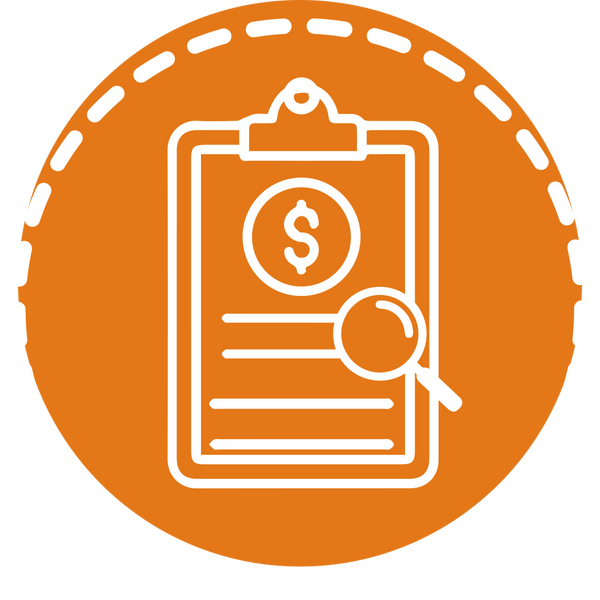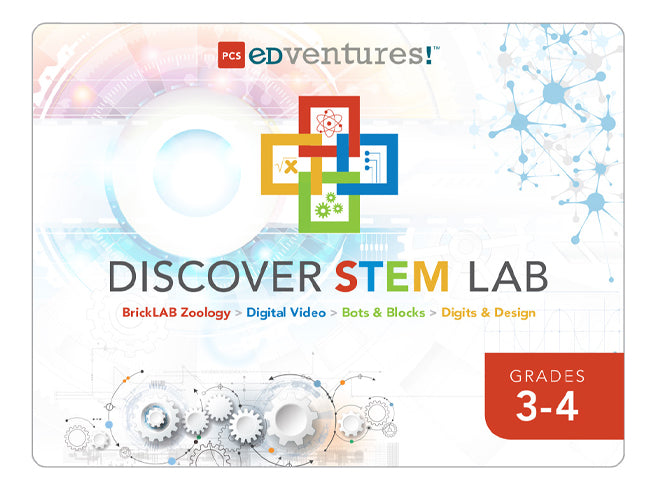
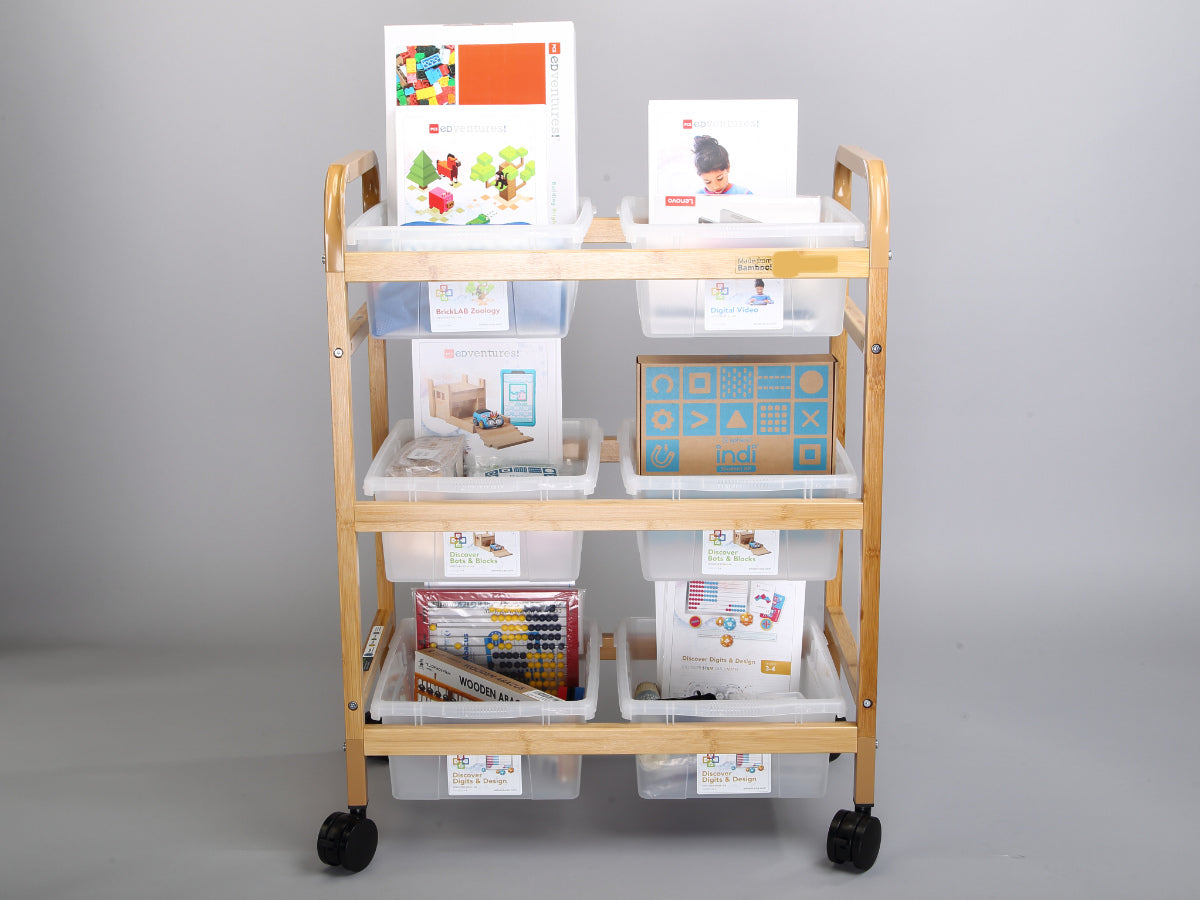
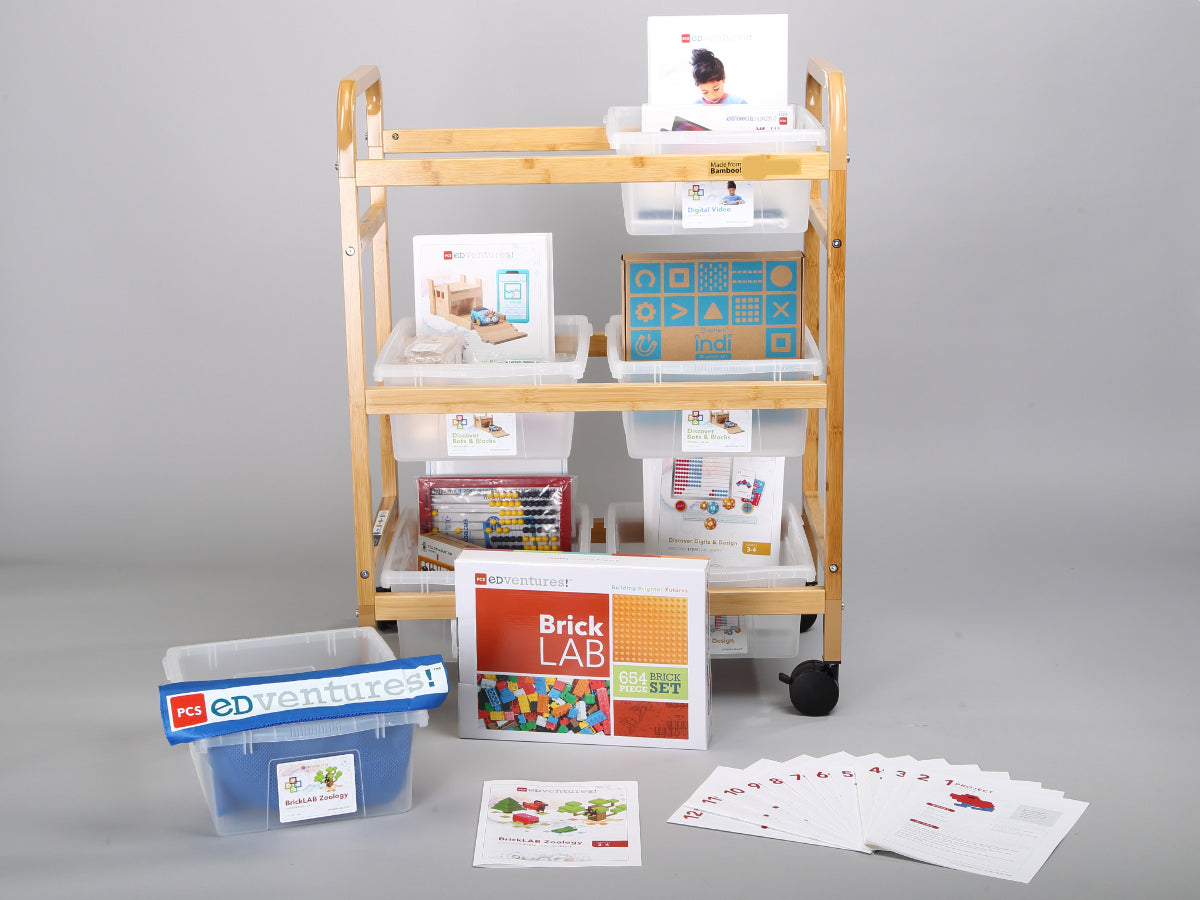
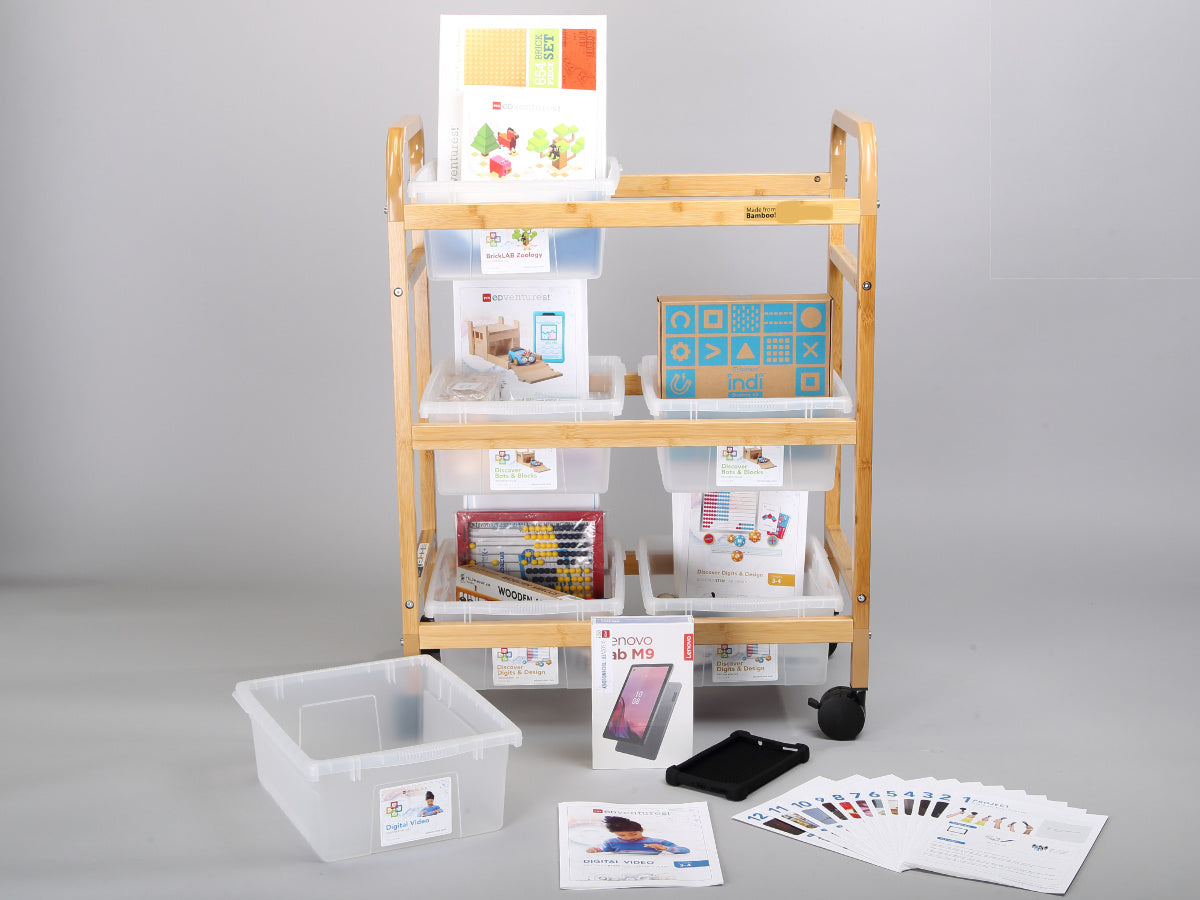
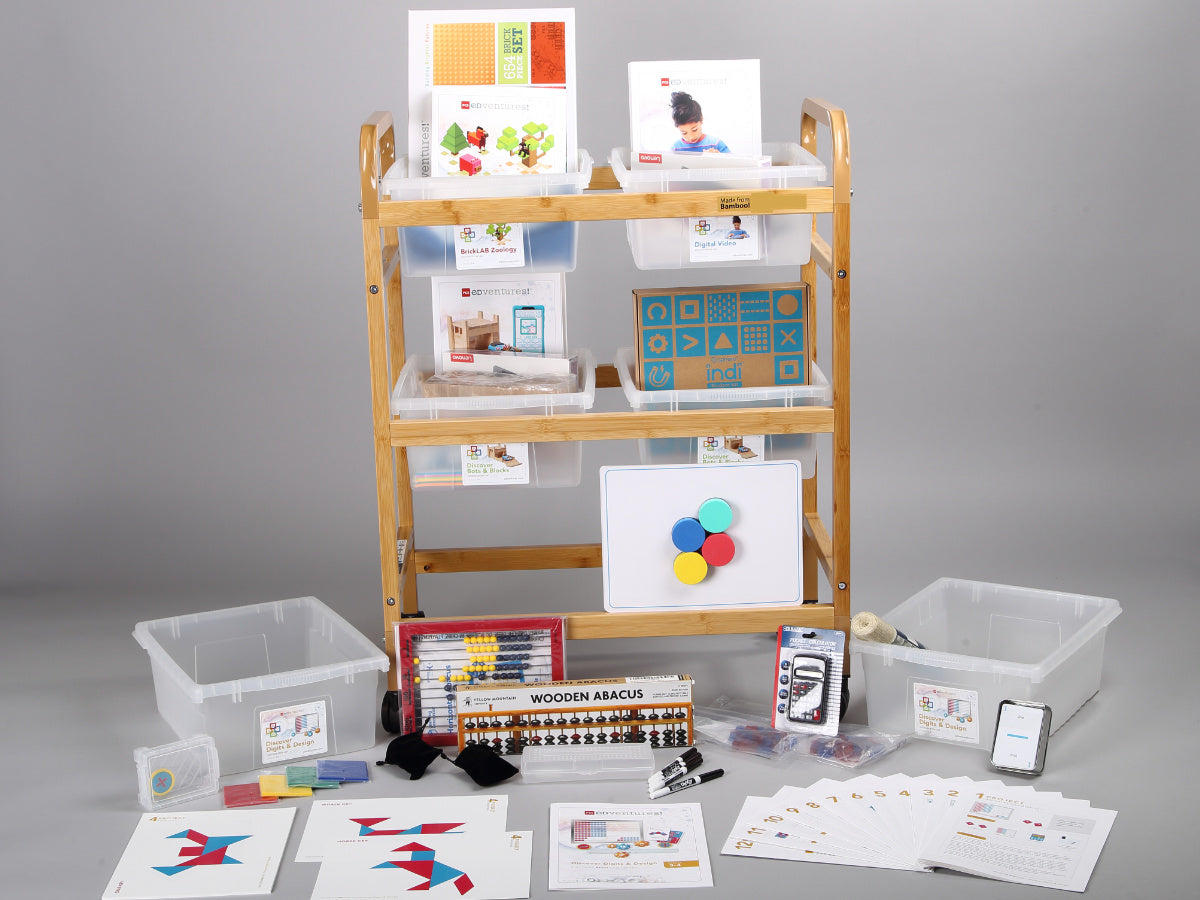
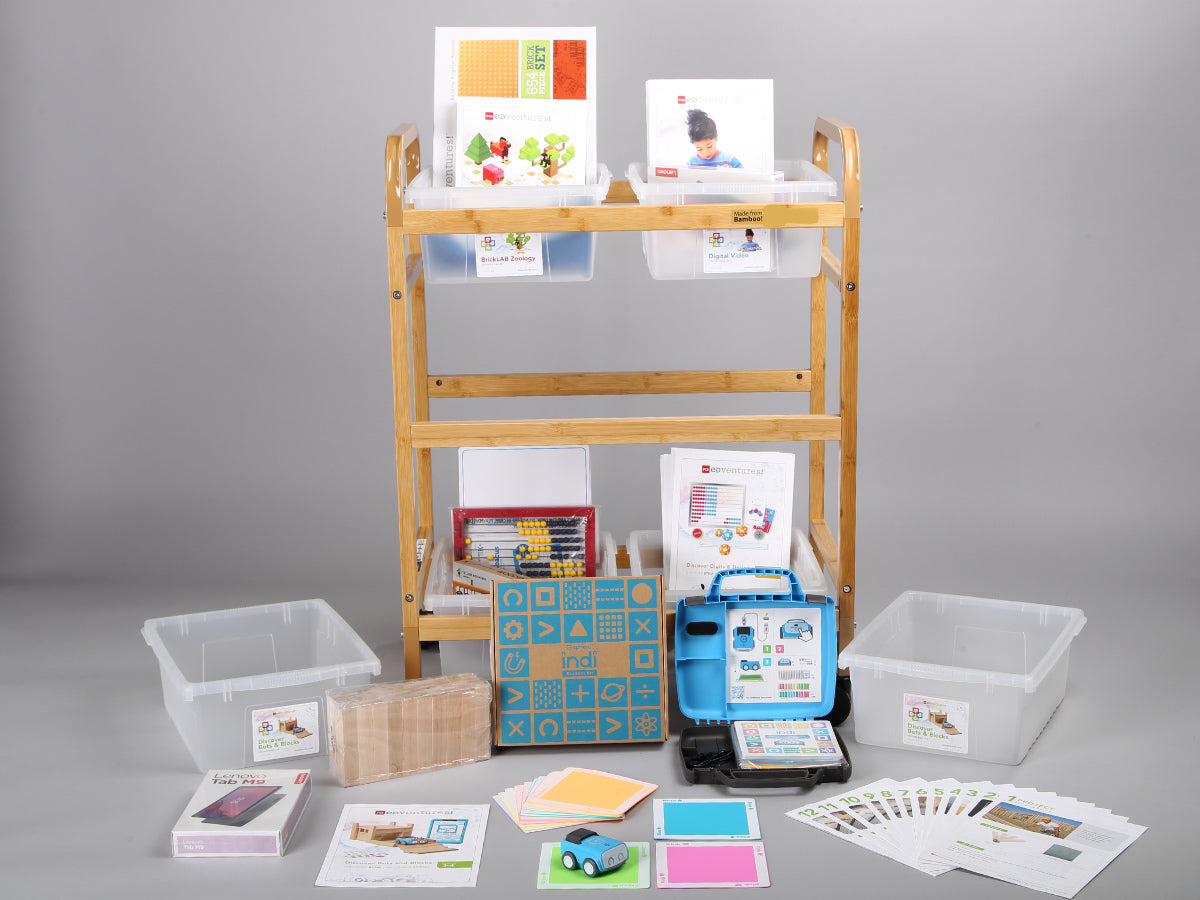
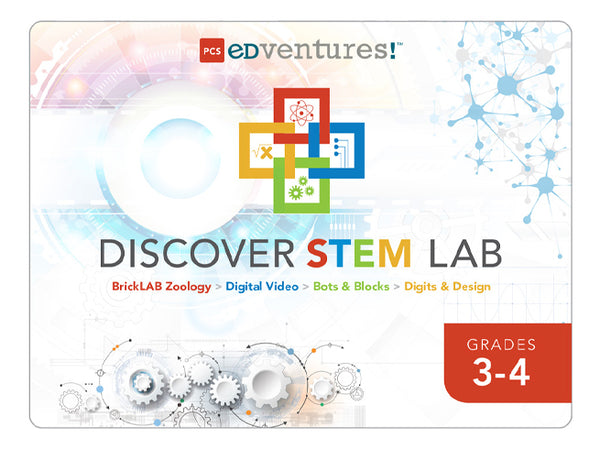
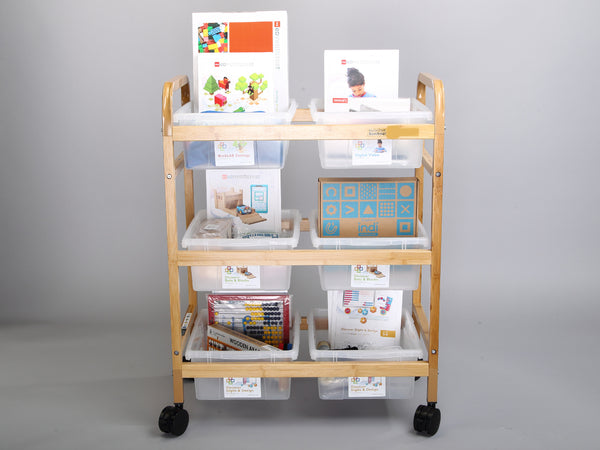
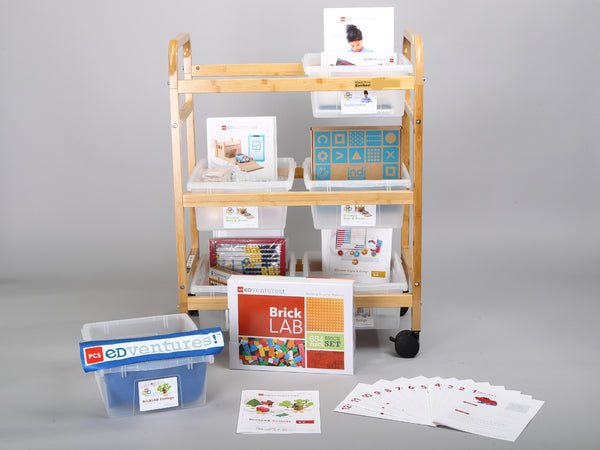
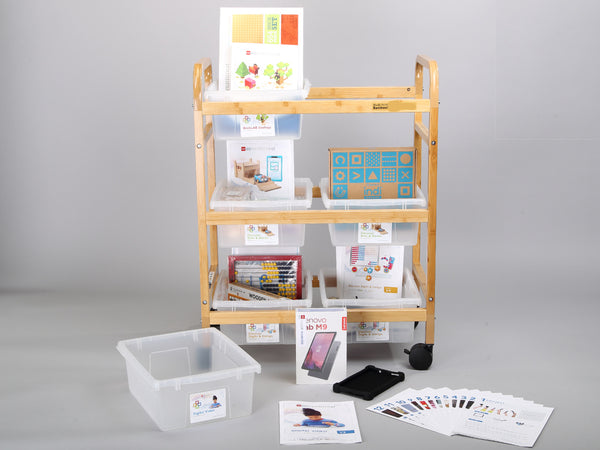
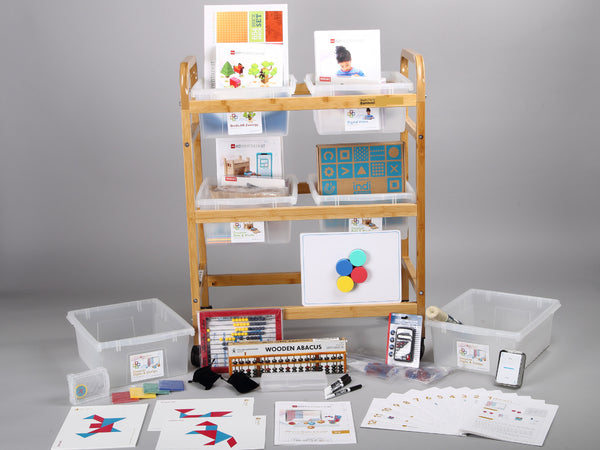
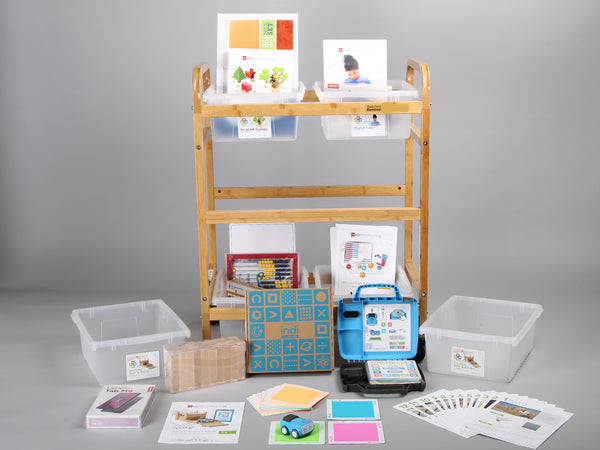






Discover STEM LAB 3-4
- Sale price
- 2,195 USD
- List price
- 2,275 USD
- You save
- 80 USD (4%)
Individual Kits Available
Perfect for home school and distance learning environments with single or small groups of students, each of the four curriculum packages included in Discover STEM LAB 3-4 can now be purchased separately:
Contact us via chat or email sales@edventures.com to discuss more customized programs with a STEM expert!
A Complete Learning Experience
STEM is all about cross-curricular exploration, and in Discover STEM LAB 3-4, students explore the ways STEM concepts can create one-of-a-kind learning experiences through scaffolded, reusable activities. Whether it’s the engineering design process or extended math concepts, each D-STEM module was selected for its easily-integrated, multi-subject capacity and contains everything you need to introduce engaging topics in any learning environment.
Like a mini-makerspace, use each module individually, or blend them for unique learning experiences. Try constructing creatures with BrickLAB Zoology, then sprinkle in the moviemaking magic of Digital Video to create exciting student films. Creativity reigns supreme in this program.
Grades: 3-4
Students: Up to 24 (Individual Kits vary)
Contact Hours: 100+
Subject Targets:
Life Science, Technology, Engineering Design, Robotics, Coding, Art/STEAM, Math Connections, English Language Arts Connections
Reusability and Expansion:
- 100% Reusable: The materials in this program are 100% reusable. Just clean and reuse again and again.
Settings & Tech Requirements
Recommended Settings:
- Classrooms
- Out-of-School Time Programs
- Libraries & Makerspaces
Tech Requirements:
- None
Curriculum Topics
Curriculum Topics:
Discover STEM LAB comes with four curriculum kits, each designed to cover specific topics.
Science: BrickLAB Zoology
In BrickLAB Zoology, 12 student-driven lessons combine manipulative-based learning for a life-science deep dive. Utilizing PCS Edventures building bricks, BrickLAB Zoology is full of hands-on lessons in animal adaptations and everything you need to send learners down the science rabbit hole. Challenging learners to examine innovations in the animal kingdom, BrickLAB Zoology creates a collaborative connection between the human and animal world, allowing learners to uncover precisely how our very different species are intertwined.
- Frogs
- Lizards
- Lobsters
- Sharks
- Crocodiles
- Beetles
- Yaks
- Pumas
- Mustangs
- Pigs
- Monkeys
- Elephants
Technology: Discover Digital Video
Start a film-intensive with application-based collaborative curriculum and survey digital documentaries, historical recreations and original films as intrinsicmotivation guides creative thinking. With a simple startup, step-by-step scaffolded activities and built-in reflections, Discover Digital Video easily introduces challenging and reusable video production skills into any learning environment.
- Interview Your Friends
- Interview a Historical Figure
- Time to Mime
- News Broadcast
- Documentary
- Cause and Effect Short
- The Hidden Life of Things
- Quiz Show
- Talent Search
- Commercial
- Infomercial
- Musical Production
Engineering: Discover Bots & Blocks
Unleash student creativity with Discover Bots & Blocks! Six engineering design activities and six coding activities engage learners in iterative thinking and develop their problem-solving skills. The easy-to-read lesson guides encourage design thinking and hands-on learning as students build structures from KEVA planks and program Sphero's robotic car, indi.
- Building Basics
- Plank Geometry
- Building Upward: Towers
- Building Outward: Cantilevering
- Building At An Angle: Slopes
- Structural Patterns: Not Just for Buildings
- Introducing indi
- Teacher’s Helper
- Obstacle Course
- Introduction to Sphero Edu Jr App
- Robots in the Real World
- Robots Rock!
Math: Discover Digits & Design
The Discover Digits & Design curriculum includes 12 student activities, divided into four groups based on fun and engaging math manipulatives. With student curriculum pages designed for independent exploration in a learner-driven environment, each problem-solving activity emphasizes specific math principles and grade-level appropriate math standards and is scaffolded so learners move upward through Bloom’s Taxonomy as they gain experience and understanding of the math concepts and extensions involved.
- Subtraction Fluency
- Multiplication Fluency
- Division Fluency
- Place Value & Multi-Digit Arithmetic
- Equivalent Fractions
- Factors and Multiples
- Pattern Generation & Analysis
- Problem Solving
Professional Development
Product Orientation:
- Half-hour free webinar orientation for purchases of $500+
- One-hour free webinar orientation for purchases of $1000+
- Additional training available for purchase
Materials
Complete Program Includes:
Each Discover STEM LAB comes with the following kits in a convenient rolling storage unit.
Science: BrickLAB Zoology
Students: Up to 3
Contact Hours: 12+
Materials:
- BrickLAB Zoology Instructor Guide: 1
- BrickLAB Zoology Student Build Books: 12
- BrickLAB Bricks: 650+
- Brick Separator: 1
Technology: Discover Digital Video
Students: Up to 3
Contact Hours: 48+
Materials:
- Discover Digital Video Instructor Guide: 1
- Tablet: 1
- Tablet Cover: 1
Engineering: Discover Bots & Blocks
Students: Up to 6
Contact Hours: 24+
Materials:
- Discover Bots & Blocks Instructor Guide: 1
- Discover Bots & Blocks Student Project Cards: 12
- Dry Erase Marker: 1
- Dry Erase Pocket: 1
- Grip Liner: 1
- KEVA Balls: 2
- KEVA Planks: 200
- Sphero indi Educational Robot Student Kit: 1
- Extra Sphero indi Rubber Tiles: 20
- Tablet: 1
- Tablet Cover: 1
- Tape Measure: 1
Math: Discover Digits & Design
Students: Up to 12
Contact Hours: 16+
Materials:
- Discover Digits & Design Instructor Guide: 1
- Discover Digits & Design Student Project Booklets: 12
- Tangram Answer Keys
- Set of Tangrams: 1
- Abacus (base ten): 1
- Abacus (classic soroban): 1
- Calculator: 1
- Dry Erase Markers: 4
- Dry Erasers: 4
- Dry Erase Axis Lap Boards: 4
- Number Line Rulers (with set of 60 cubes): 2
- PCS Card Deck: 1
- Polyhedral Dice (7 pack): 2
- +/- Integer Chip: 1
Standards & Alignment
Common Core State Standards for Mathematics:
- CCSS.MATH.CONTENT.3.G.A.1 Understand that shapes in different categories (e.g., rhombuses, rectangles, and others) may share attributes (e.g., having four sides), and that the shared attributes can define a larger category (e.g., quadrilaterals). Recognize rhombuses, rectangles, and squares as examples of quadrilaterals, and draw examples of quadrilaterals that do not belong to any of these subcategories.
- CCSS.MATH.CONTENT.3.MD.C.5 Recognize area as an attribute of plane figures and understand concepts of area measurement.
- CCSS.MATH.CONTENT.3.MD.C.7.B Multiply side lengths to find areas of rectangles with whole-number side lengths in the context of solving real world and mathematical problems, and represent whole-number products as rectangular areas in mathematical reasoning.
- CCSS.MATH.CONTENT.3.MD.D.8 Solve real world and mathematical problems involving perimeters of polygons, including finding the perimeter given the side lengths, finding an unknown side length, and exhibiting rectangles with the same perimeter and different areas or with the same area and different perimeters.
- CCSS.MATH.CONTENT.4.G.A.1 Draw points, lines, line segments, rays, angles (right, acute, obtuse), and perpendicular and parallel lines. Identify these in two-dimensional figures.
- CCSS.MATH.CONTENT.4.G.A.2: Classify two-dimensional figures based on the presence or absence of parallel or perpendicular lines, or the presence or absence of angles of a specified size. Recognize right triangles as a category, and identify right triangles.
- CCSS.MATH.CONTENT.4.MD.A.3 Apply the area and perimeter formulas for rectangles in real world and mathematical problems.
- CCSS.MATH.CONTENT.4.MD.C.5 Recognize angles as geometric shapes that are formed wherever two rays share a common endpoint, and understand concepts of angle measurement.
- CCSS.MATH.CONTENT.4.MD.C.5.A An angle is measured with reference to a circle with its center at the common endpoint of the rays, by considering the fraction of the circular arc between the points where the two rays intersect the circle. An angle that turns through 1/360 of a circle is called a “one-degree angle,” and can be used to measure angles.
- CCSS.MATH.CONTENT.3.G.A.1 Understand that shapes in different categories (e.g., rhombuses, rectangles, and others) may share attributes (e.g., having four sides), and that the shared attributes can define a larger category (e.g., quadrilaterals). Recognize rhombuses, rectangles, and squares as examples of quadrilaterals, and draw examples of quadrilaterals that do not belong to any of these subcategories.
- CCSS.MATH.CONTENT.3.MD.C.5 Recognize area as an attribute of plane figures and understand concepts of area measurement.
- CCSS.MATH.CONTENT.3.MD.C.7.B Multiply side lengths to find areas of rectangles with whole-number side lengths in the context of solving real world and mathematical problems, and represent whole-number products as rectangular areas in mathematical reasoning.
- CCSS.MATH.CONTENT.3.MD.D.8 Solve real world and mathematical problems involving perimeters of polygons, including finding the perimeter given the side lengths, finding an unknown side length, and exhibiting rectangles with the same perimeter and different areas or with the same area and different perimeters.
- CCSS.MATH.CONTENT.4.G.A.1 Draw points, lines, line segments, rays, angles (right, acute, obtuse), and perpendicular and parallel lines. Identify these in two-dimensional figures.
- CCSS.MATH.CONTENT.4.G.A.2: Classify two-dimensional figures based on the presence or absence of parallel or perpendicular lines, or the presence or absence of angles of a specified size. Recognize right triangles as a category, and identify right triangles.
- CCSS.MATH.CONTENT.4.MD.A.3 Apply the area and perimeter formulas for rectangles in real world and mathematical problems.
- CCSS.MATH.CONTENT.4.MD.C.5 Recognize angles as geometric shapes that are formed wherever two rays share a common endpoint, and understand concepts of angle measurement.
- CCSS.MATH.CONTENT.4.MD.C.5.A An angle is measured with reference to a circle with its center at the common endpoint of the rays, by considering the fraction of the circular arc between the points where the two rays intersect the circle. An angle that turns through 1/360 of a circle is called a "one-degree angle," and can be used to measure angles.
- CCSS.MATH.CONTENT.4.MD.C.6 Measure angles in whole-number degrees using a protractor. Sketch angles of specified measure.e points where the two rays intersect the circle.
Common Core State Standards Initiative © Copyright 2010. National Governors Association Center for Best Practices and Council of Chief State School Officers. All rights reserved.
Next Generation Science Standards:*
- NGSS K-2-ETS1-1. Engineering Design
- NGSS K-2-ETS1-2. Engineering Design
- NGSS 2-LS4-1. Biodiversity
- NGSS 3-5-ETS1-1. Engineering Design
- NGSS 3-5-ETS1-2 Engineering Design
- NGSS 3-5-ETS1-3 Engineering Design
* Next Generation Science Standards and NGSS is a registered trademark of WestEd. Neither WestEd nor the lead states and partners that developed the Next Generation Science Standards were involved in the production of this product, and do not endorse it.
International Society for Technology in Education:
- Creativity and Innovation: Students demonstrate creative thinking, construct knowledge, and develop innovative products and processes using technology.
- Critical Thinking, Problem Solving, and Decision Making: Students use critical thinking skills to plan and conduct research, manage projects, solve problems, and make informed decisions using appropriate digital tools and resources.
- Communication and Collaboration with a Digital Portfolio: Students can use digital media and environments to communicate and work collaboratively, including at a distance, to support individual learning and contribute to the learning of others.
- Research and Information Fluency: Students apply digital tools and gather, evaluate, and use information.
ISTE Standards for Students, ©2016, ISTE® (International Society for Technology in Education), iste.org. All rights reserved. ISTE was not involved in the production of this product and does not endorse it.
ITEEA Standards:
- ITEEA #1: Develop an understanding of the characteristics and scope of technology.
- ITEEA #2: Develop an understanding of the core concepts of technology.
- ITEEA #3: Develop an understanding of the relationships among technologies and the connections between technology and other fields of
study. - ITEEA #4: Develop an understanding of the cultural, social, economic, and political effects of technology.
- ITEEA #5: Develop an understanding of the effects of technology on the environment.
- ITEEA #6: Develop an understanding of the role of society in the development and use of technology.
- ITEEA #7: Develop an understanding of the influence of technology on history.
- ITEEA #8: Develop an understanding of the attributes of design.
- ITEEA #9: Develop an understanding of engineering design.
- ITEEA #10: Develop an understanding of the role of troubleshooting, research, and development, invention and innovation, and experimentation
in problem solving. - ITEEA #12: Develop the abilities to use and maintain technological products and systems.
- ITEEA #13: Develop the abilities to assess the impacts of products and systems.
- ITEEA #15: Develop an understanding of and be able to select and use agricultural and related biotechnologies.
- ITEEA #16: Develop an understanding of and be able to select and use energy and power technologies.
- ITEEA #20: Develop an understanding of and be able to select and use construction technologies.
© 2018 International Technology and Engineering Educators Association (ITEEA). All Rights Reserved. ITEEA was not involved in the production of this product and does not endorse it.
Idaho K-12 Content Standards for Computer Science:
While computer science standards vary from state-to-state, we hope this list of the Idaho State Standards provides a useful starting point for your alignment.
- 3-5.CS.01 Create code to model intelligent behavior in computing devices (e.g. CS unplugged activities, robot programming). (Grades 3-5)
- 3-5.AP.02 Construct and test problem solutions using a block-based visual programming language, both independently and collaboratively (e.g. pair programming). (Grades K-5)
- 3-5.AP.07 Construct an algorithm to accomplish a task, both independently and collaboratively.(Grades K-5)
About the Author
PCS Edventures Development Team:
PCS Edventures programs are crafted by educators, for educators. Our development team includes educators, curriculum specialists, writers and artists from all backgrounds. Together, we create programs that close learning gaps, promote equity, meet educational standards, support social-emotional learning, explore real-world careers and instill a life-long love of STEM in learners worldwide!
With decades of combined experience in classrooms, summer camps, after-school programs and so much more, your learning environment is in great hands.
Shipping Information
Payment and Return Policy
Thank you for choosing PCS Edventures! We want to make your shopping experience with us a pleasant one. The following is our general policy concerning payment, returns, product shipping, and warranties.
Payment Information
We accept Purchase Orders (POs)*, checks, VISA, MasterCard, American Express, and Discover as forms of payment. During payment processing, we will verify your billing and shipping address. Please be sure that you enter your information accurately.
*Purchase Orders are subject to review by PCS Edventures. We reserve the right to accept or reject any Purchase Order at our discretion.
Shipping
PCS Edventures does not include the cost of shipping in its product pricing. Your shipping rate will depend on your delivery location.
We ship through Federal Express or United States Postal Service. Please provide a physical address for shipping. We are unable to ship to PO Boxes.
If your order requires expedited shipping, please contact our office at sales@edventures.com or (208) 343-3110.
Tax
Sales tax is automatically applied to any transaction that will ship to the states listed below. If you are tax exempt, please contact us at sales@edventures.com or (208) 343-3110.
Idaho: Sales tax is added, unless proper documentation for your exempt status is provided. This is required by the State of Idaho.
California: Sales tax is added to all transactions. This is required by the State of California.
Washington: Sales tax is added to all transactions. This is required by the State of Washington.
Georgia: Sales tax is added, unless proper documentation for your exempt status is provided. This is required by the State of Georgia.
New Jersey: Sales tax is added, unless proper documentation for your exempt status is provided. This is required by the State of New Jersey.
United States Customers: Please provide your organization’s Tax Identification Number or tax-exempt certification form as described in IRC Section 501 (c)(3) of the Code.
Order Fulfillment
Many products are assembled and packaged after an order is received. Typical order fulfillment time is 2-5 business days from your order date.
The products listed on our website contain materials that may be discontinued by our vendors without notice. Lead times to receive materials from our vendors may extend significantly due to a variety of factors. A sales representative will contact you within 48 hours if your order has been impacted by these issues or any other reason.
If your order requires expedited shipping, please contact our office at sales@edventures.com or (208) 343-3110 so we can try to accommodate your request. If you need delivery outside the continental United States, please contact us for shipping costs. We do not ship to PO Boxes.
Partial Fulfillment
PCS Edventures products are designed to be ready-to-use and accessible for any educator. This often requires some components to be sourced from third-party vendors. Occasionally, this may cause delays in order fulfillment.
In such cases, orders may be partially fulfilled to meet deadlines. A PCS Edventures representative will contact you if your order is subject to partial fulfillment. After the initial shipment, any delayed components will be shipped to you as soon as possible.
Return Policy
To return a product, you must first obtain a Return Merchandise Authorization ("RMA") number from PCS Edventures. To receive an RMA number, contact PCS Edventures at (208) 343-3110 within fifteen (15) business days of receipt of your product(s). Returned items must be received by PCS Edventures within thirty (30) calendar days after issuance of the RMA number or the return right will be forfeited and the RMA number becomes null and void.
All returned items must be returned postage prepaid and insured by you, in original packaging, in "as-shipped" condition, unopened and with all parts, accessories, and written materials included.
PCS Edventures may charge a restocking fee for returned items of up to thirty percent (30%), depending on circumstances. There may also be a product damage or missing-item fee in an amount determined by PCS Edventures for any product that is damaged, or is missing the original box, contents, accessories, and/or manuals (i.e., any product not in "as-shipped" condition).
These fees will apply unless the item was defective or damaged when shipped, you received the wrong item, or the fee is prohibited by law.
If you paid by credit card, you authorize PCS Edventures to debit your credit card for the amount of any fees required by PCS Edventures pursuant to this Return Policy.
PCS Edventures Warranty Information
1. LIMITED WARRANTY. PCS guarantees our products with a 30-day limited warranty against material or workmanship defects and will accept any defective item for refund or exchange. Unused or defective merchandise may be returned within 30 days after purchase for an exchange. THIS IS THE ONLY GUARANTEE OR WARRANTY BEING OFFERED BY PCS RELATING TO THE PRODUCTS AND SERVICES YOU PURCHASE OR RECEIVE FROM PCS. PCS MAKES NO OTHER, AND EXPRESSLY DISCLAIMS ALL, REPRESENTATIONS, WARRANTIES AND CONDITIONS, WHETHER IN WRITING, IMPLIED, OR STATUTORY, INCLUDING ANY WARRANTY OF MERCHANTABILITY OR FITNESS FOR ANY PARTICULAR PURPOSE, OR ANY WARRANTY ARISING FROM COURSE OF DEALING OR USAGE OF TRADE. EXCEPT AS OTHERWISE COVERED BY THE LIMITED WARRANTY, PRODUCTS AND SERVICES PROVIDED BY PCS ARE PROVIDED "AS IS" AND WITHOUT WARRANTY OF ANY KIND BY PCS. Manufacturers of non-PCS branded products may provide other warranties. Warranty claims for non-PCS branded products will be handled by their respective manufacturers.
2. Exclusivity of Remedy; Limitation of Liability. YOUR SOLE AND EXCLUSIVE REMEDY, AND PCS' SOLE AND EXCLUSIVE LIABILITY, FOR ANY BREACH OF WARRANTY SHALL BE YOUR RIGHT TO RECEIVE A REPLACEMENT PRODUCT. IN NO EVENT SHALL PCS BE LIABLE FOR SPECIAL, INDIRECT, INCIDENTAL, CONSEQUENTIAL OR PUNITIVE DAMAGES, INCLUDING LOST PROFITS OR LOSS OF BUSINESS, EVEN IF IT HAS BEEN ADVISED OF THE POSSIBILITY OF SUCH DAMAGES, NOR SHALL THE AGGREGATE LIABILITY OF PCS, WHETHER IN CONTRACT, WARRANTY, TORT, PRODUCT LIABILITY, STRICT LIABILITY OR OTHER THEORY, ARISING OUT OF OR RELATING TO THESE TERMS OR THE PURCHASE OR USE OF ANY PRODUCTS EXCEED THE PURCHASE PRICE OF THE PRODUCT. ANY LEGAL ACTION AGAINST PCS FOR BREACH OF THESE TERMS OF SALE, INCLUDING ANY WARRANTIES, MUST BE INSTITUTED WITHIN ONE YEAR AFTER DELIVERY OF GOODS.
3. Governing Law. The warranty terms are governed by the laws of the State of Idaho and the state courts of Idaho.
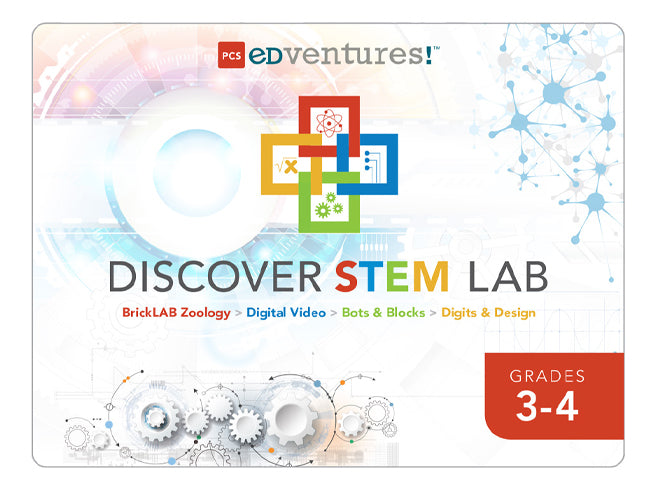
Discover STEM LAB 3-4
Pricing Options:
- 2,275.00 USD 2,195.00 USD
Recommended Settings:
- Classrooms
- Out-of-School Time Programs
- Libraries & Makerspaces
Tech Requirements:
- None
Curriculum Topics:
Discover STEM LAB comes with four curriculum kits, each designed to cover specific topics.
Science: BrickLAB Zoology
In BrickLAB Zoology, 12 student-driven lessons combine manipulative-based learning for a life-science deep dive. Utilizing PCS Edventures building bricks, BrickLAB Zoology is full of hands-on lessons in animal adaptations and everything you need to send learners down the science rabbit hole. Challenging learners to examine innovations in the animal kingdom, BrickLAB Zoology creates a collaborative connection between the human and animal world, allowing learners to uncover precisely how our very different species are intertwined.
- Frogs
- Lizards
- Lobsters
- Sharks
- Crocodiles
- Beetles
- Yaks
- Pumas
- Mustangs
- Pigs
- Monkeys
- Elephants
Technology: Discover Digital Video
Start a film-intensive with application-based collaborative curriculum and survey digital documentaries, historical recreations and original films as intrinsicmotivation guides creative thinking. With a simple startup, step-by-step scaffolded activities and built-in reflections, Discover Digital Video easily introduces challenging and reusable video production skills into any learning environment.
- Interview Your Friends
- Interview a Historical Figure
- Time to Mime
- News Broadcast
- Documentary
- Cause and Effect Short
- The Hidden Life of Things
- Quiz Show
- Talent Search
- Commercial
- Infomercial
- Musical Production
Engineering: Discover Bots & Blocks
Unleash student creativity with Discover Bots & Blocks! Six engineering design activities and six coding activities engage learners in iterative thinking and develop their problem-solving skills. The easy-to-read lesson guides encourage design thinking and hands-on learning as students build structures from KEVA planks and program Sphero's robotic car, indi.
- Building Basics
- Plank Geometry
- Building Upward: Towers
- Building Outward: Cantilevering
- Building At An Angle: Slopes
- Structural Patterns: Not Just for Buildings
- Introducing indi
- Teacher’s Helper
- Obstacle Course
- Introduction to Sphero Edu Jr App
- Robots in the Real World
- Robots Rock!
Math: Discover Digits & Design
The Discover Digits & Design curriculum includes 12 student activities, divided into four groups based on fun and engaging math manipulatives. With student curriculum pages designed for independent exploration in a learner-driven environment, each problem-solving activity emphasizes specific math principles and grade-level appropriate math standards and is scaffolded so learners move upward through Bloom’s Taxonomy as they gain experience and understanding of the math concepts and extensions involved.
- Subtraction Fluency
- Multiplication Fluency
- Division Fluency
- Place Value & Multi-Digit Arithmetic
- Equivalent Fractions
- Factors and Multiples
- Pattern Generation & Analysis
- Problem Solving
Product Orientation:
- Half-hour free webinar orientation for purchases of $500+
- One-hour free webinar orientation for purchases of $1000+
- Additional training available for purchase
Complete Program Includes:
Each Discover STEM LAB comes with the following kits in a convenient rolling storage unit.
Science: BrickLAB Zoology
Students: Up to 3
Contact Hours: 12+
Materials:
- BrickLAB Zoology Instructor Guide: 1
- BrickLAB Zoology Student Build Books: 12
- BrickLAB Bricks: 650+
- Brick Separator: 1
Technology: Discover Digital Video
Students: Up to 3
Contact Hours: 48+
Materials:
- Discover Digital Video Instructor Guide: 1
- Tablet: 1
- Tablet Cover: 1
Engineering: Discover Bots & Blocks
Students: Up to 6
Contact Hours: 24+
Materials:
- Discover Bots & Blocks Instructor Guide: 1
- Discover Bots & Blocks Student Project Cards: 12
- Dry Erase Marker: 1
- Dry Erase Pocket: 1
- Grip Liner: 1
- KEVA Balls: 2
- KEVA Planks: 200
- Sphero indi Educational Robot Student Kit: 1
- Extra Sphero indi Rubber Tiles: 20
- Tablet: 1
- Tablet Cover: 1
- Tape Measure: 1
Math: Discover Digits & Design
Students: Up to 12
Contact Hours: 16+
Materials:
- Discover Digits & Design Instructor Guide: 1
- Discover Digits & Design Student Project Booklets: 12
- Tangram Answer Keys
- Set of Tangrams: 1
- Abacus (base ten): 1
- Abacus (classic soroban): 1
- Calculator: 1
- Dry Erase Markers: 4
- Dry Erasers: 4
- Dry Erase Axis Lap Boards: 4
- Number Line Rulers (with set of 60 cubes): 2
- PCS Card Deck: 1
- Polyhedral Dice (7 pack): 2
- +/- Integer Chip: 1
Common Core State Standards for Mathematics:
- CCSS.MATH.CONTENT.3.G.A.1 Understand that shapes in different categories (e.g., rhombuses, rectangles, and others) may share attributes (e.g., having four sides), and that the shared attributes can define a larger category (e.g., quadrilaterals). Recognize rhombuses, rectangles, and squares as examples of quadrilaterals, and draw examples of quadrilaterals that do not belong to any of these subcategories.
- CCSS.MATH.CONTENT.3.MD.C.5 Recognize area as an attribute of plane figures and understand concepts of area measurement.
- CCSS.MATH.CONTENT.3.MD.C.7.B Multiply side lengths to find areas of rectangles with whole-number side lengths in the context of solving real world and mathematical problems, and represent whole-number products as rectangular areas in mathematical reasoning.
- CCSS.MATH.CONTENT.3.MD.D.8 Solve real world and mathematical problems involving perimeters of polygons, including finding the perimeter given the side lengths, finding an unknown side length, and exhibiting rectangles with the same perimeter and different areas or with the same area and different perimeters.
- CCSS.MATH.CONTENT.4.G.A.1 Draw points, lines, line segments, rays, angles (right, acute, obtuse), and perpendicular and parallel lines. Identify these in two-dimensional figures.
- CCSS.MATH.CONTENT.4.G.A.2: Classify two-dimensional figures based on the presence or absence of parallel or perpendicular lines, or the presence or absence of angles of a specified size. Recognize right triangles as a category, and identify right triangles.
- CCSS.MATH.CONTENT.4.MD.A.3 Apply the area and perimeter formulas for rectangles in real world and mathematical problems.
- CCSS.MATH.CONTENT.4.MD.C.5 Recognize angles as geometric shapes that are formed wherever two rays share a common endpoint, and understand concepts of angle measurement.
- CCSS.MATH.CONTENT.4.MD.C.5.A An angle is measured with reference to a circle with its center at the common endpoint of the rays, by considering the fraction of the circular arc between the points where the two rays intersect the circle. An angle that turns through 1/360 of a circle is called a “one-degree angle,” and can be used to measure angles.
- CCSS.MATH.CONTENT.3.G.A.1 Understand that shapes in different categories (e.g., rhombuses, rectangles, and others) may share attributes (e.g., having four sides), and that the shared attributes can define a larger category (e.g., quadrilaterals). Recognize rhombuses, rectangles, and squares as examples of quadrilaterals, and draw examples of quadrilaterals that do not belong to any of these subcategories.
- CCSS.MATH.CONTENT.3.MD.C.5 Recognize area as an attribute of plane figures and understand concepts of area measurement.
- CCSS.MATH.CONTENT.3.MD.C.7.B Multiply side lengths to find areas of rectangles with whole-number side lengths in the context of solving real world and mathematical problems, and represent whole-number products as rectangular areas in mathematical reasoning.
- CCSS.MATH.CONTENT.3.MD.D.8 Solve real world and mathematical problems involving perimeters of polygons, including finding the perimeter given the side lengths, finding an unknown side length, and exhibiting rectangles with the same perimeter and different areas or with the same area and different perimeters.
- CCSS.MATH.CONTENT.4.G.A.1 Draw points, lines, line segments, rays, angles (right, acute, obtuse), and perpendicular and parallel lines. Identify these in two-dimensional figures.
- CCSS.MATH.CONTENT.4.G.A.2: Classify two-dimensional figures based on the presence or absence of parallel or perpendicular lines, or the presence or absence of angles of a specified size. Recognize right triangles as a category, and identify right triangles.
- CCSS.MATH.CONTENT.4.MD.A.3 Apply the area and perimeter formulas for rectangles in real world and mathematical problems.
- CCSS.MATH.CONTENT.4.MD.C.5 Recognize angles as geometric shapes that are formed wherever two rays share a common endpoint, and understand concepts of angle measurement.
- CCSS.MATH.CONTENT.4.MD.C.5.A An angle is measured with reference to a circle with its center at the common endpoint of the rays, by considering the fraction of the circular arc between the points where the two rays intersect the circle. An angle that turns through 1/360 of a circle is called a "one-degree angle," and can be used to measure angles.
- CCSS.MATH.CONTENT.4.MD.C.6 Measure angles in whole-number degrees using a protractor. Sketch angles of specified measure.e points where the two rays intersect the circle.
Common Core State Standards Initiative © Copyright 2010. National Governors Association Center for Best Practices and Council of Chief State School Officers. All rights reserved.
Next Generation Science Standards:*
- NGSS K-2-ETS1-1. Engineering Design
- NGSS K-2-ETS1-2. Engineering Design
- NGSS 2-LS4-1. Biodiversity
- NGSS 3-5-ETS1-1. Engineering Design
- NGSS 3-5-ETS1-2 Engineering Design
- NGSS 3-5-ETS1-3 Engineering Design
* Next Generation Science Standards and NGSS is a registered trademark of WestEd. Neither WestEd nor the lead states and partners that developed the Next Generation Science Standards were involved in the production of this product, and do not endorse it.
International Society for Technology in Education:
- Creativity and Innovation: Students demonstrate creative thinking, construct knowledge, and develop innovative products and processes using technology.
- Critical Thinking, Problem Solving, and Decision Making: Students use critical thinking skills to plan and conduct research, manage projects, solve problems, and make informed decisions using appropriate digital tools and resources.
- Communication and Collaboration with a Digital Portfolio: Students can use digital media and environments to communicate and work collaboratively, including at a distance, to support individual learning and contribute to the learning of others.
- Research and Information Fluency: Students apply digital tools and gather, evaluate, and use information.
ISTE Standards for Students, ©2016, ISTE® (International Society for Technology in Education), iste.org. All rights reserved. ISTE was not involved in the production of this product and does not endorse it.
ITEEA Standards:
- ITEEA #1: Develop an understanding of the characteristics and scope of technology.
- ITEEA #2: Develop an understanding of the core concepts of technology.
- ITEEA #3: Develop an understanding of the relationships among technologies and the connections between technology and other fields of
study. - ITEEA #4: Develop an understanding of the cultural, social, economic, and political effects of technology.
- ITEEA #5: Develop an understanding of the effects of technology on the environment.
- ITEEA #6: Develop an understanding of the role of society in the development and use of technology.
- ITEEA #7: Develop an understanding of the influence of technology on history.
- ITEEA #8: Develop an understanding of the attributes of design.
- ITEEA #9: Develop an understanding of engineering design.
- ITEEA #10: Develop an understanding of the role of troubleshooting, research, and development, invention and innovation, and experimentation
in problem solving. - ITEEA #12: Develop the abilities to use and maintain technological products and systems.
- ITEEA #13: Develop the abilities to assess the impacts of products and systems.
- ITEEA #15: Develop an understanding of and be able to select and use agricultural and related biotechnologies.
- ITEEA #16: Develop an understanding of and be able to select and use energy and power technologies.
- ITEEA #20: Develop an understanding of and be able to select and use construction technologies.
© 2018 International Technology and Engineering Educators Association (ITEEA). All Rights Reserved. ITEEA was not involved in the production of this product and does not endorse it.
Idaho K-12 Content Standards for Computer Science:
While computer science standards vary from state-to-state, we hope this list of the Idaho State Standards provides a useful starting point for your alignment.
- 3-5.CS.01 Create code to model intelligent behavior in computing devices (e.g. CS unplugged activities, robot programming). (Grades 3-5)
- 3-5.AP.02 Construct and test problem solutions using a block-based visual programming language, both independently and collaboratively (e.g. pair programming). (Grades K-5)
- 3-5.AP.07 Construct an algorithm to accomplish a task, both independently and collaboratively.(Grades K-5)
PCS Edventures Development Team:
PCS Edventures programs are crafted by educators, for educators. Our development team includes educators, curriculum specialists, writers and artists from all backgrounds. Together, we create programs that close learning gaps, promote equity, meet educational standards, support social-emotional learning, explore real-world careers and instill a life-long love of STEM in learners worldwide!
With decades of combined experience in classrooms, summer camps, after-school programs and so much more, your learning environment is in great hands.





